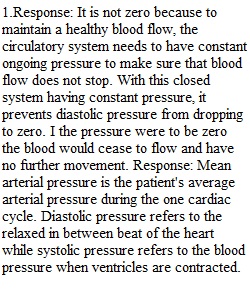


Q Week 6, part 1 Labs Responses: Cardiovascular Physiology Refer to the Week 6, part 1 Lab Instructions available in Canvas for the experimental steps and question prompts. Blood Pressure Simulation Table 1: Simulated Patient Cardiac Data Patient Systolic Diastolic MAP 1 124 70 88 2 144 83 103 3 129 80 96 4 139 93 5 154 99 6 125 65 7 128 76 8 120 77 Question 1. Why is blood pressure not zero during diastole? Explain your answer. Blood Pressure Activity Table 2: Volunteer Cardiac Data Background Questions 1. Why do you think that MAP is NOT calculated as (SAP + DAP)/2? 2. What were your predictions for what should have happened to MAP when moving from a supine to standing position? What about heart rate? Explain why. Blood pressure homeostasis is described by the following equation: MAP=CO×TPR In your textbook this is rearranged to CO = MAP/TPR (as flow = pressure/resistance). CO (cardiac output) is the total volume of blood flowing out of the heart and through the vessels. CO can be further described as HR x SV, where HR is beats per minute, and SV (stroke volume) is the amount of blood pumped out of the heart with each beat. TPR (total peripheral resistance) is the resistance to blood flow in the systemic circuit. If stroke volume decreased, everything else being equal, then what would happen to MAP? What would have to change in order to keep CO the same?
View Related Questions